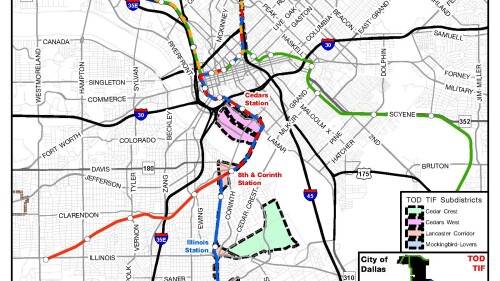Infrastructure
Infrastructure was accordingly a rich theme for the MIT Center for Advanced Urbanism’s two inaugural conferences, whose proceedings are now available in two intriguing volumes, concerning both the rote realities of appropriate functionality, Scaling Infrastructure, and the possibilities of civic and connective consequentiality, Infrastructural Monument.
Journalist Edward Humes is a Pulitzer Prize winner and author of 14 books. In Door to Doorhe takes on another complex, resource-intensive topic: the mammoth transportation systems that make it possible (and often frighteningly impossible) for Americans to drive 344 million miles in an hour and move $55 billion worth of goods per day.
ULI member and urban planner Patrick Kennedy recently appeared on the Streetsblog podcast, Talking Headways, to discuss Kennedy’s highway removal campaign for Dallas, known as “A New Dallas,” and the recent Texas DOT CityMap Plan to re-imagine the freeways and roads in the city’s downtown.
Southern Dallas, which was physically and economically separated from downtown after the construction of Interstate 30 in the 1960s, is undergoing a renaissance focused on transit-oriented development.
When the Uber went online last year in Fukuoka, the biggest city in Japan’s south, it was shut down within a matter of weeks by the government on the grounds that the vehicles used did not belong to Uber, which violated the nation’s Road Transportation Act. The company’s second attempt to break into the nation of 127 million has involved a different strategy: cooperating with taxi companies.
How can we prepare for disasters and adverse events in ways that protect communities and enhance the built environment? Experts in resilience discuss efforts to protect communities from disaster, enhance recovery efforts, increase awareness about the value of incorporating resilience, and implement resilience projects that provide additional benefits to the community.
Real estate and transportation are increasingly becoming interconnected, Rob Speyer, president and chief executive of Tishman Speyer, told those attending the ULI Asia Pacific Summit in Shanghai this past June.
The gleaming white terminal on the cover suggests a book much like many others, outlining a future (and present) of grand planning for the prosperity brought and dispatched via the wonders of air traffic. But this is not that book: it is a fascinating examination of the many elements that such forecasts leave out or overlook.
The noted California architect and planner discusses China’s new “urban design revolution.” In an interview, Calthorpe spoke to ULI about how the new standards address this explosive growth and the involvement of his Berkeley, California–based design firm, Calthorpe Associates, in promoting sustainable development in China.
Panelists at the recent ULI Japan Conference in Tokyo said that even a mature market such as Japan offers significant opportunities, due to a program of public/private partnerships designed to ease the burden on the state, but a $1 trillion “infrastructure gap” exists worldwide.






